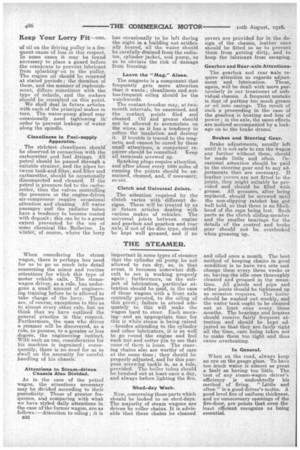THE STEAMER.
Page 6

If you've noticed an error in this article please click here to report it so we can fix it.
When considering the steam wagon, there is perhaps less need for us to go so much into detail concerning the minor and routine attentions for which this type of motor vehicle • calls. The steamwagon driver, as a rule, has, undergone a small amount of engineering training before he is allowed to take charge of the lorry. There are, of course, exceptions to this as to almost every other rule, but we think that we have outlined the general practice in this respect. Furthermore, the man who drives a steamer will be discovered, as a rule, to possess, to a greater or less degree, the engineering instinct. With such an one, consideration for his machine is ingrained ; consequently, there is no need for us to dwell on the necessity for careful handling of his chassis.
Attentions to Steam-driven Chassis Also Divided.
As in the case of the petrol wagon, the attentions necessary may be divided according to their periodicity. Those of greater Irequence, and comparing with what we have styled daily attentions in the case of the former wagon, are as follows :—Attention to oiling ; it is 1330 important in some types of steamer that the cylinder oil pump be not allowed to run. dry, as, in that event, it becomes somewhat difficult to set it working properly again; furthermore, on the subject of lubrication, particular attention should be paid, in the case of those wagons with a front axle centrally pivoted, to the oiling of this pivot; failure to attend adequately to this will make the wagon hard to steer. Each morning—and an appropriate time for this is while steam is being raised —besides attending to the cylinder and other lubricators, it is as well to go round the engine and feel each nut and cotter pin to see that none of tham is loose. The steering chains also are worthy of care at the same time ; they should be properly adjusted, and. for this purpose screwing tackle is, as a rule, provided. The boiler tubes should be brushed out at least once a day, and always before lighting the fire.
Shed-day Work.
Now, concerning those parts which should be looked to on shed-days. The majority of steam warns are driven by roller chains. It is advisable that these chains be cleaned and oiled once a month. The best method of keeping chains in good condition is to have two sets and change them every three weeks or so, having, the idle ones thoroughly cleaned and greased in the meantime. All glands and pipe and other joints should•be tightened up as occasion requires. The boiler should be washed out weekly, and the water tank ought to be cleaned out at least once every three months. The bearings and brasses should receive fairly frequent attention and should be kept adjusted so that they are fairly tight all the time, care being taken not to make them too tight and thus cause overheating.
In General.
When on. the road, always keep an eye on the gauge glass. To have too much water is almost as great a fault as having too little. The test of any steam-wagon driver's efficiency is undoubtedly his niethocl of firing. "Little and often" is a good driver's motto. A good level fire of uniform thickness, and no unnecessary openings of the fire-door, are points that even the least efficient recognize as being essential.






















